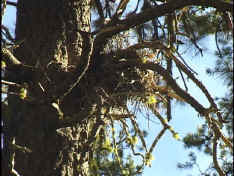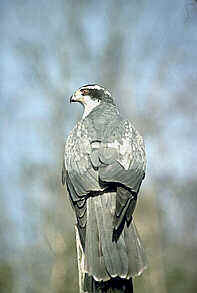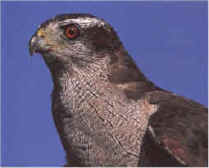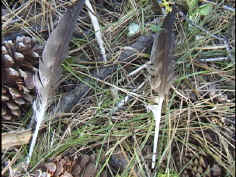|
DESIMONE STUDY
Desimone, S.M. 1997. Occupancy rates and habitat relationships of northern goshawks in
historic nesting areas in Oregon. M.S. Thesis, Oregon State University, Corvallis, OR.
Goshawks in eastern Oregon occupied historic territories 29% of the time and recently
discovered/occupied territories 79% of the time. Sixty percent of recently
discovered/occupied nest sites were in old, closed canopied forests (>15 trees/ha
>=53 cm (21") dbh, >50% canopy cover), 26% were in mid-aged, closed forest
(23-53 cm dbh, <15 trees/ha >53 cm (21") , >50% canopy closure). The 15
historic nest sites which continued to be occupied had significantly more mid-aged, closed
forest and old, closed forests than the 31 historic nest sites which were unoccupied. This
relationship was significant within 12, 24, 52, 120, and 170 ha circles surrounding
goshawk territory centers.
Nest success of occupied/historical sites (70%) and young per nest (1.5) was comparable
to recently discovered/historical sites (77% and 1.39).
The occupancy rate of recently discovered territories (79%) was similar to rates of
recently discovered territories in AZ, NM, CA, UT and OR (range= 66%-74%) that had a low
level of habitat disturbance. The occupancy rate of historic territories, however, was
only 29%. All of the unoccupied/historic territories had logging within the 52 ha nest
site: "this strongly suggests that the low detection rate…was largely the result
of habitat alteration; i.e. the conversion of Late Closed and Mid-aged Closed forest
conditions to mainly Very Early seral stage of Early Open canopy forest conditions within
the 52 ha alternate nest cluster."
As of 1994, only 2-8% of the Freemont National Forest is in late successional pine
types (page 55, Henjum et al. 1994:5). Using historic goshawk nests, late closed forests
decreased 50% since the 1970s, mid-aged closed forest 20%-40%,. Very early forest increase
400% to 1,000%, early open forest increased as well (Table 11, figure 5).
Good discussion of accipiter reoccupancy rates (p. 56).
Tree harvest prescriptions that create large areas with sparse cover (e.g. Very Early,
Early Open, Mid Open, Late Open) are potentially detrimental to goshawk occupancy,
especially if the percent of open canopy (<50% CC) forest is >33.7% (mean) at the 52
ha scale or >43.8% (mean) of the total area of the 170 PFA (Table 12)."
"Analysis of the Fremont vegetative cover types suggests that any habitat
manipulation resulting in substantial reduction of mature, closed-canopy forests, which is
subsequently replaced by early successional or more open young forest, would reduce the
suitability of an area as a potential nest site (McCarthy et al. 1989)…My analysis
suggests that more severe alterations (regeneration clearcuts, partial removal of stands
resulting in <50% canopy closure, and moderately high to severe alteration) may be
better predictors of goshawks not nesting in areas where nest site potential has
significantly deteriorated and become non-suitable for nesting."
- "I suggest a 52 ha (130 acres) no-harvest zone within the alternate nest cluster
and discourage further cutting of large, late and old structure trees (>53 cm) within
the PFA to preserve stand integrity, maintain closed canopies, maintain connectivity to
alternate nests stands, and optimize conditions for breeding goshawk pairs to persist. The
delineated 52 ha should include at least 2 alternate nest stands in addition to the
existing nest stand and should have similar suitable structural conditions as the known
nest area. Nest stands should be delineated to include the most late-successional,
closed-canopy forest structure surrounding the nest trees as possible (a minimum of 30% of
the 12 ha nest stand [this study]). Outside the 52 ha nest cluster, the remainder of the
170 ha PFA should retain all existing Mid-age and Late vegetation structure possible. I
recommend that <20% of the PFA should be in Very Early and Early Open vegetative cover
types." Ed: This also suggests that occupancy rates of recently discovered
territories is not an indicator of changes in total occupancy rates or population
densities.
Within the 52 ha scale, occupied/historic nest sites had 49% total old closed and
mid-aged closed forest, while unoccupied/historic nest sites had 19% total old closed and
mid-aged closed forest. The current relationship between forest structure and occupancy
matches the historic relationship: all historic nest sites averaged 51% total old closed
and mid-aged closed forest when last known to be occupied prior to the study. At the 12 ha
level, occupied/historic nest sites had 400% more old closed forest than
unoccupied/historic nest sites.
The Freemont National Forest (Oregon) summarized the recommendations of Desimone (1997)
as such:
"These studies represent the best information available...[Desimone] confirmed the
importance of late closed and mid-age closed forests as indicators of quality habitat
within the 52 ha scale on historic nest sites where goshawks were still present in
1994...suggesting that little or no habitat alteration within aggregate nest stands is
important to ensure persistence of nesting pairs."
MCGRATH STUDY
McGrath, M.T. 1997. Northern goshawk habitat analysis in managed forest
landscapes.M.S., Oregon State University, Corvallis, OR.
82 active nest and 95 random sites were analyzed in eastern Oregon and Washington.
Nest sites (1 ha) typically occurred on the lower 1/3 or bottom of a north facing
slope. They had higher basal areas, larger trees, higher canopy closure, and greater live
stem density compared to random sites. Mean age was statistically greater than average (by
11 years) and mean distance to human disturbance was less (by 8 m) than random sites, but
were not likely biologically detectable to goshawks.
Nest stands (10 ha) were in mid-old forests with canopy >=50%.
Theoretical PFAs excluding the nest stand (10-83 ha) were negatively correlated with
early forest conditions.
PFAs (170 ha) were not different from random sites.
NORTON STUDY
Norton, B.E..1994.Characteristics of northern goshawk (Accipiter gentilis atricapillus)
nest sites within the Siskiyou Mountains of northern California and southern Oregon. Rogue
River National Forest, Medford, OR.
All five known goshawk nests on the Applegate Ranger District of the Rogue River
National Forest (OR) were in old growth or mature stands though such forests make up only
39.37% of the district. The nests, however, were found during timber harvest surveys
rather than by random or systematic surveys.
Mean canopy closure, as measured by spherical densiometer, of four active nest stands
was 88% (range = 75-97). Mean nest stand size was 851.4 acres, while the average
mature/old growth stand on the district is 118.6 acres.
Nests were in Douglas-fir, ponderosa pine, and madrone. Mean nest tree DBH was 81.84 cm
(32.22 in.) (range = 50.80 - 124.46 cm). Two of four nests were in mistletoe clumps.
Average nest height was 18 m (59 ft) (range = 12 - 24 m). All nests were within the
lower 1/3 of the canopy.
Nest sites were on "relatively moderate" slopes for the areas (average 36%,
range = 27-58%) with north and east aspect.
Mean distance to riparian area was 436 m (range = 180 - 660).
Mean distance to road was 1,198 m (range = 180 - 3,300).
Understories were "open" but not quantified.
Ponderosa pine and Douglas-fir were the dominant overstory trees.
ALLISON STUDY
Allison, B.A. 1996. A landscape characterization of nesting goshawk habitat in northern
California using remote sensing and GIS. M.S. Thesis, Southern Illinois University at
Edwardsville, Edwardsville, IL.
100% of 16 nests systematically found in two survey areas (13,360 and 14,250 ha) were
in mature-old forest stands on north facing slopes. Most were between 1,700 and 1,900 m in
elevation and on <20% slopes
The amount, size of patches, edge density, and edge contrast of light density and dense
mature-old forest was significantly greater in goshawk nest stands and within 800 m (= 500
acres = .5 mile radius) of nests than in control plots. Larger amounts of old growth
within 800 m may be more important on less mesic sites.
80 ha (200 acres) of light density and dense mature-old forest should be maintained
within 800 m of goshawk nests. Lodgepole stands and meadows should be maintained.
Protection of meadows and riparian areas is also important for adequate prey populations,
and the homogenous distribution of different vegetation types and seral stages should also
be maintained to provide high contrast edge for foraging.
BLOOM ET AL.
Bloom, P.H., G.R. Stewart and B.J. Walton. 1986. The status of the northern goshawk in
California, 1981-1983. California Fish and Game Department, Sacramento, CA.
Statewide, five to ten territories are being destroyed yearly due to logging. Between
1981 and 1983, six territories on National Forest lands were lost to logging. Some
inactive territories had extensive logging in them.
Goshawks are doing poorly in the Northern Coast Ranges-Klamath Mountains and on the
east side of the Sierra Nevada.
The Forest Service should increase protected nest stands from 10-32 ha (25-80 acres) to
a minimum of 50 ha (125 acres), and increase the total number of protected territories.
"In our judgement, this still places territories at risk and only selective cutting
should be permitted adjacent to this area." "protecting only a nest stand
probably is not adequate to maintain a productive territory."
If prey densities are high, logging is light, and forest buffers are left around nest
stands, then 25-80 acre nest stand may be adequate.
FOWLER
Fowler, C. 1988. Habitat capability model for the northern goshawk. USDA Forest Service
Region 5, Tahoe National Forest, Nevada City, Nevada. 21 pp.
Minimum nest stand should be 50 ha (124 acres). "Stands less than 50 ha will
reduce protection from disturbance and increase the possibility of inactivity and
abandonment."
"Where management for the current population is desired, establish at least four
territories per township across suitable habitat" (3.5 to 10 miles between
territories).
- "Integrating goshawk habitat with pileated woodpecker and spotted owl management
areas "should be done with caution or avoided because of the potential for goshawk
predation on these species."
"Preponderance" lands within goshawk territories should have overstories
trees averaging 25-30" dbh exceeding 60% canopy closure. The nest core should not by
isolated by logging.
Maintain meadows and streams. Edges increase prey diversity, but are probably not a
limiting factor.
SAUNDERS
Saunders, L.B. 1982. Essential nesting habitat of the goshawk (Accipiter gentilis) on
the Shasta-Trinity National Forest, McCloud District. M.S. Thesis, California State
University, Chico, CA.
7,436 ha of potentially suitable habitat was surveyed for goshawks on the McCloud
District of the Shasta-Trinity National Forest. Seven newly discovered and 6 historical
nest areas were analyzed.
Mean nest stand canopy closure was 77% (range = 53-92). The majority of nest stands had
less than 25% ground cover and 200-300 stems per acre.
Nest sites were similar to nest stands, but had a greater density of large trees and
generally higher canopy closure (mean = 81%). Stem density varied with 41% of sites having
<200 stems/acre.
Distance to water was highly variable (15-1,700 m, 44-5,576 ft). 75% of nests were at
least 100 m from water.
58% of nest were on slopes. 48% were on the lower third or toe of a slope. Five on flat
ground, which is very prevalent on the McCloud District.
All nest were in the lower portion of the canopy.
Orientation varied greatly, the largest number facing north-east.
SCHWEICH
Schweich, M. 1997. Results of five years of goshawk monitoring on the Modoc National
Forest. Modoc National Forest.
Habitat within the 600 PFA on 52 territories with "high quality" surveys over
five years (1992-1996) were compared with nesting success. Of the 15 territories with less
than 180 acres of "quality habitat" only 8 produced at least one fledgling in
five years. Of the 18 territories with 180-348 acres of quality habitat, 16 produced at
least one fledgling in five years. Of the 19 territories with more than 348 acres of
quality habitat, 17 were successful at least one in five years.
The territories with less than 180 acres of quality habitat had a mean reproductive
success rate of 27% while the latter two were 41% and 43% respectively.
WOODBRIDGE AND DETRICH
Woodbridge, B. and P. Detrich. 1994. Territory occupancy and habitat patch size of
northern goshawks in the southern Cascades of California. Studies in Avian Biology
16:83-87.
- Territories typically contained 3-9 nest trees. The mean number used was 2.6 (range =
1-5). Forty-four percent of nest trees were also used in the previous year. Forty-nine
percent of nest trees were used at least twice in five years.
Distribution of alternate nests was variable. Most were clumped within 2-3 adjacent
stands, some were up to 2.1 km away. The mean distance was 273 m. Longer movement may not
have been detected.
Territories typically contained 1-5 nest stands, ranging from 4.1 to 115 ha in size.
85% of nest stands were less than .7 km apart.
Individual nest stands were occupied in 46% of years. Stands <10 ha were
"occasionally" occupied, while stands >20 ha were occupied in a "high
proportion" of years.
Clusters of nest stands ranged from 10.5 to 114 ha in size. Most nest stand clusters
were clearly distinct of nest stand clusters in neighboring territories, 18% (5)
territories, however, had widely dispersed clusters with less distinct territory
boundaries.
The mean occupancy rate of nest stand clusters was 74%. Occupancy of clusters <20 ha
was <50%, 40 ha was 75-80%, and >61 ha was nearly 100%. "...patch size may be
an important factor determining quality of nesting habitat."
Long-term monitoring did demonstrate a distinction between post-fledging family areas
and alternate nest stand.
87% of 84 nesting attempts were successful (i.e. produced a fledgling).
Average productivity was 1.93 young per attempt. There was no relationship between
stand size cluster and productivity. The mean number of young per occupied territory was
relatively uniform. Nest success and productivity were likely overestimated.
In 23 "traditional" territories where occupancy was predictable, nest
clusters were distinct. In the 5 "ephemeral" territories where occupancy was
sporadic, nest stands were widely spaced. They were highly fragmented areas of lodgepole
and mixed-pine with extensive bark beetle mortality. High prey densities or
vulnerabilities may have attracted goshawks to nest in these areas with little mature
forest.
Historic logging has caused the study area to contain scatted patches of
mature forest within a matrix of thinned and regenerating stands, yet it contains
relatively dense goshawk populations. "Goshawk territories, however, were associated
with the larger remaining patches of mature forest, and territory occupancy was positively
correlated with the size of nesting habitat patches." Go
back to page 8 of Story Home |
|



